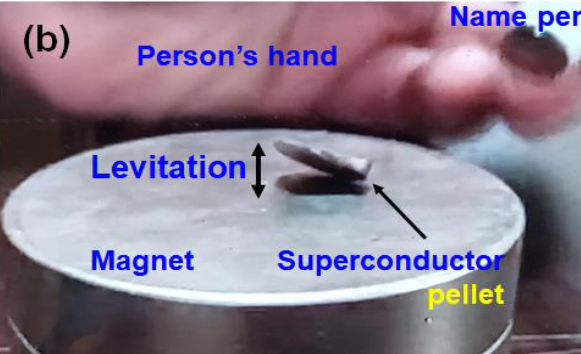- cross-posted to:
- physics@mander.xyz
- cross-posted to:
- physics@mander.xyz
For the first time in the world, we succeeded in synthesizing the room-temperature superconductor (Tc≥400 K, 127∘C) working at ambient pressure with a modified lead-apatite (LK-99) structure. The superconductivity of LK-99 is proved with the Critical temperature (Tc), Zero-resistivity, Critical current (Ic), Critical magnetic field (Hc), and the Meissner effect. The superconductivity of LK-99 originates from minute structural distortion by a slight volume shrinkage (0.48 %), not by external factors such as temperature and pressure. The shrinkage is caused by Cu2+ substitution of Pb2+(2) ions in the insulating network of Pb(2)-phosphate and it generates the stress. It concurrently transfers to Pb(1) of the cylindrical column resulting in distortion of the cylindrical column interface, which creates superconducting quantum wells (SQWs) in the interface. The heat capacity results indicated that the new model is suitable for explaining the superconductivity of LK-99. The unique structure of LK-99 that allows the minute distorted structure to be maintained in the interfaces is the most important factor that LK-99 maintains and exhibits superconductivity at room temperatures and ambient pressure.
There's already all kinds of shit that's room temperature, big whoop. I wish Liberal LIEntists would stop wasting their time and our tax dollars.
Cold Fission? Big whoop, my fridge is cold. Folks, science is wasting our time!
Oh shit, the synthesis for this looks really easy. Like "every YouTube chemist is going to do this" easy.
Wake me up when the practical applications drop. I've lived through several decades of, "This changes EVERYTHING!!!!" articles, and I'm still waiting for something to change.
this would make maglev trains significantly cheaper, faster, and more efficient. basically anything that needs powerful magnets or where high current would generate an an unacceptable amount of heat. it's applications are all in infrastructure, though, so we won't see any of it in the US.
it's applications are all in infrastructure, though, so we won't see any of it in the US
Nah. We will see it used by the US Navy. There is a reason a lot of the funding for higher temperature super conductors comes from the US Navy. They use super conducting coils in the hulls of warships to generate a field powerful enough to protect against torpedoes and mines. Not needing to cool such systems means more electricity freed up for new toys like directed energy weapons or even more power radar.
Ambient temperature and pressure is the actual game-changer that could make it practical. All of the previous stuff has required supercooling, extreme pressure, or both, and all of the "this changes everything" has been based on the hope that it could provide a path to this: room temperature semiconductors.
Practical applications would be for maglev trains, MRI machines, electrical distribution grids, electric motors, basically anything where you have magnets or really high current.
Could someone explain to my dumb dumb brain what this is in smaller words?

Whenever electricity is conducted through something there's a loss of some of those electrons. A superconductor minimises the loss but our current methods of doing that are in like MRI machines where you need to have expensive cooling mechanisms to achieve the superconducting properties. With a room temperature one, you can cheaply manufacture ones that can be used in all kinds of settings and that can prevent long-distance efficiency loss which makes things like desert solar farms impractical. We could have ultra-efficient engines, better magnetic levitation, and cheap refrigeration without chemicals.
no electrons were lost to make this post lmao. resistance is like friction for electricity. as electrons scoot through a wire, they slow down due to the friction-like effect. this generates heat, which becomes prohibitive (like metal melting prohibitive) at high current, and the energy that becomes heat is just lost, so we have to burn more fossil fuels to make up the difference. superconductors are called that because they have no resistance. up to this point, the only superconductors required absurdly low temperatures - close to the -273C limit - something so prohibitively expensive to achieve that we only bother with superconductors where not using them would destroy machines. but this looks to be so easy to make that there's no reason this wouldn't just replace copper basically everywhere.
ofc capitalism is a fuck so this will probably get locked behind patents forever and ever.
I'd like to add that most current "High temperature superconductors" (ie. -30C or below rather than the liquid Helium types) have major application limitations since they aren't "true superconductors" in the original sense of the term. These guys seem to be c
laiming a proper 4 Kelvin-style Superconductor at room temp which is...uhhh...an interesting claim up there with Cold Fusion, FTL, or Diamonoid Mechanosynthesis (ie. Proper Nanotech)Uhh no it's actually a fairly limited superconductor, still a huge breakthrough in materials science, just more of the level of..."OLED screens" instead of "Steel"
Very big if true, and if they can get high current flow through it eventually. Room temperature superconductors enables things like inter-continental electrical transmission, which would make ramping up solar production way more feasible.
Is this the same guy from like Rensselaer or somewhere like that the everyone is pretty sure has faked the hell out of all his results?
Just noticed there was a link, this is at least not the same people. Still be very skeptical though, this is basically a holy grail of materials science.
At least on Stormfront nobody has taken issue with their credentials yet, only that it's preliminary research without peer-review yet: https://www.reddit.com/r/worldnews/comments/159g2k4/roomtemperature_superconductor_discovered/
Important to note that Arvix is a pre-publication non-peer reviewed repository. However Prof. Young-Wan Kwon is a PhD at a South Korean university with other papers to his credit so this is a pretty bold move for him to pre-publish this as it could be a career ender if he's wrong about this.
Rensselaer guy is the anti-climate change libertarian think tank dude. You're thinking of Jan Hendrik Schön.
Here's a picture of it levitating on a magnet.
Show
Apparently there are materials that can do this that aren't superconductors, but it is superconductor-y.
Note that it's not doing a very good job at levitating. Apparently it's kind of bad at some of the stats people want a room conducting superconductor for*. Also note that it's levitating next to some guy's hand and his hand isn't falling off from frostbite. That's the room temperature part.
* I am being vague and handwavy because I don't want to give you the impression I know what the fuck I'm talking about.
(Image source is a different paper by the same people)
















